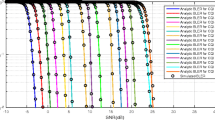Abstract
A novel link adaptation scheme using linear Auto Regressive (AR) model channel estimation algorithm to enhance the performance of auto rate selection mechanism in IEEE 802.11g is proposed. This scheme can overcome the low efficiency caused by time interval between the time when Received Signal Strength (RSS) is measured and the time when rate is selected. The best rate is selected based on data payload length, frame retry count and the estimated RSS, which is estimated from recorded RSSs. Simulation results show that the proposed scheme enhances mean throughput performance up to 7%, in saturation state, and up to 24% in finite load state compared with those non-estimation schemes, performance enhancements in average drop rate and average number of transmission attempts per data frame delivery also validate the effectiveness of the proposed scheme.
Similar content being viewed by others
References
IEEE Std802.11g. Part11: Wireless LAN medium access control (MAC) and physical layer (PHY) specifications: further higher data rate extension in the 2.4GHz band. Jun. 2003.
A. J. van der Vegt. Auto rate fallback algorithm for the IEEE 802.11a standard. Master Dissertation, Utrecht University, 2002.
Gavin Holland, Nitin Vaidya, Paramvir Bahl. A rate-adaptive MAC protocol for multi-hop wireless networks. MOBICOM’01, Rome, Italy, July 2001, 236–251.
B. Sadeghi, V. Kanodia, A. Sabharwal, et al. Opportunistic media access for multi-rate ad hoc networks. MOBICOM’02, Georgia, USA, 2002, 486–497.
Daji Qiao, Sunghyun Choi, Kang G. Shin. Goodput analysis and link adaptation for IEEE 802.11a wireless LANs. IEEE Trans. on Mobile Computing, 1(2002)4, 278–292.
Jd. P. Pavon, Sunghyun Choi. Link adaptation strategy for IEEE 802.11 WLAN via received signal strength measurement. ICC’03, Anchorage, Alaska, USA, 2003, vol.2, 1108–1113.
IEEE Std802.11. Part11: Wireless LAN medium access control (MAC) and physical layer (PHY) specifications. Aug. 1999.
Daji Qiao, Sunghyun Choi, Amjad Soomro, et al. Energy-efficient PCF operation of IEEE 802.11a WLANs via transmit power control. Computer Networks, 42(2003)1, 39–54.
Y. C. Tay, K. C. Chua. A capacity analysis for the IEEE 802.11 MAC protocol. Wireless Network, 7(2001)2, 159–171.
Lin Zhenghan, Huang Aiping, Qiu Peiliang. Measurement of number of contending stations in IEEE 802.11 WLAN. Journal of Circuits and Systems, 8(2003)5, 37–42, (in Chinese).
U. C. Berkeley, et al. NS notes and documentation. Available from http://www.isi.edu/nsnam/ns/ns-documentation.html, Dec. 2003.
Author information
Authors and Affiliations
Corresponding author
Additional information
Partly supported by the National Hi-Tech Research and Development Program of China (863 Program) (No.2003AA143040).
About this article
Cite this article
Chen, L., Hu, A. A novel link adaptation scheme to enhance performance of IEEE 802.11g wireless LAN. J. of Electron.(China) 23, 350–354 (2006). https://doi.org/10.1007/s11767-004-0150-y
Received:
Revised:
Published:
Issue Date:
DOI: https://doi.org/10.1007/s11767-004-0150-y




